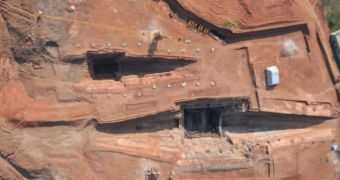A recent paper in the journal Chinese Archeology details the discovery of a mausoleum believed to be over 2,000 years old, in the Xuyi County in China's Jiangsu province.
Archaeologists who have had the chance to study this burial place say that, according to evidence at hand, the mausoleum was built to honor a king whose name was Liu Fei and who passed away in the year 128 BC.
Historic records indicate that, when alive, Liu Fei was the ruler of a kingdom named Jiangdu. By the looks of it, he held on to this status for about 26 years before dying and being buried, Live Science informs.
As detailed in the journal Chinese Archeology, the 2,100-year-old mausoleum discovered in China's Jiangsu Province took several years to excavate. Thus, archaeologists started digging in this region in 2009, and finished in 2011.
Information shared with the public says that the burial place comprises 3 main tombs and 11 attendant ones. 4 pits, of which 2 served to house horses and chariots and 2 were intended to hold weapons, are also part of the mausoleum.
While exploring the former, archaeologist stumbled upon the remains of five life-size chariots, all of which were in remarkably good shape given their age. As the researchers put it, “The lacquer and wooden parts of the chariots were all exquisitely decorated and well preserved.”
Interestingly enough, it looks like whoever built this monument also erected a wall meant to encompass the tombs and the pits, and keep them safe from curious gazes. This wall is believed to have been about 1,608 feet (490 meters) long in its heydays.
Researchers say that, judging by how many artifacts have until now been recovered from at this archaeological site, i.e. weapons, musical instruments, jewelry, about 100,000 ancient coins, and even vessels for food and wine, king Liu Fei's funeral must have been rather sumptuous.
Unfortunately, the king's body has not yet been found. Thus, it appear to be nowhere on site, and archaeologists suspect that it was removed from inside its designated coffin many years ago, when the mausoleum was plundered. It is unclear where it might be.
“Near the coffins many jade pieces and fragments, originally parts of the jade burial suit, were discovered. These pieces also indicate that the inner coffin, originally lacquered and inlaid with jade plaques, was exquisitely manufactured,” archaeologists say.
For the time being, archaeologists cannot say for sure whose remains ended up occupying the tombs close to the one intended for king Liu Fei. However, they suspect that at least one of these tombs, inside which they found a rather impressive coffin, was intended for a person of high status.

 14 DAY TRIAL //
14 DAY TRIAL //